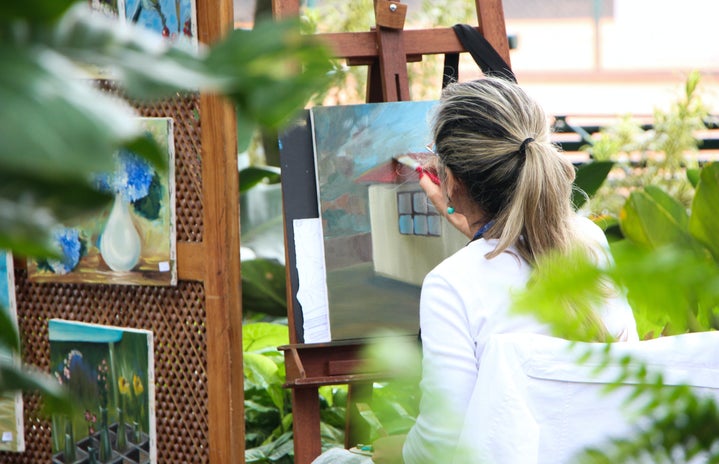This is not a story about how a white afro-wearing man in jeans and a button up shirt became the voice of the Millenial and Gen Z social relaxation everywhere, but the moto he chooses to perpetuate among the masses: Anyone can paint. Take this to heart, and you’ll be painting like Bob Ross in no time.
Though the work behind some of our most iconic paintings requires creativity, the actual practice of painting does not. That’s right, those who once considered themselves art-lacking can find joy in the practice of colorful pigments just as much as the rest of us.
I, myself, am an artist at heart. I took crafts classes before I could spell my name. I drew rainbows, painted abstract portraits (not on purpose), and yelled at kids who colored outside the lines (unless it was proper shading). A collaged flower I made in preschool would be Monet-worthy if it weren’t for its tipsy-looking butterfly friend also glued to the page with paste I was definitely not supposed to eat (but did).
And yet, my sister was never gifted with my skills. Sure, she can do math, but who needs that?
But, throughout the years, as we both became more stressed and occupied by the not-so-fun parts of life, we started to paint together. I taught her a few simple steps for still-lifes and she explained my math homework. How did we do it? Don’t worry, I’ll share.
Tip #1: Use the right brush.
Makeup is considered a craft in my book. So, why do people understand they can’t apply eyeshadow with a blush brush until they pick up a paintbrush?
To start off right, you need the right tool. Round brushes that make a point when wet are used for watercolor. Flat brushes, that don’t, are used for acrylic, oil, and tempera. If you don’t know the difference between those, just read the label on the bottle you’re using.
Tip #2: Start with small strokes.
Think of your brush like a pencil. You need to be able to control it well, in order for it to do what you want. When starting out, try taking the brush towards its hairs. Start with small strokes and sections of color. This can make a painting look more detailed, rather than the large swatches of color most beginners use. This is part of what makes Bob’s pieces so fantastic.
Tip #3: Blend your colors.
Most people know how to mix primary colors; blue and yellow make green, red and blue make purple, yellow and red make orange. But there are so many other cool combinations, shades, and tints that can come from playing around with some paint.
So, rather than using the colors just as they came from the can, try mixing them up, adding some dimension, and imagining shadow through blending the colors on your pallet.
Mix white into colors for a lighter tint, or complementary colors for a darker shade.
Tip #4: Don’t take yourself too seriously.
Did you mess up? Not possible. In “true art,” there is only improvement. You don’t have to know exactly what you want to do when you set out with a canvas (or paper). The point is to become better artists and practice your skills in a safe environment. So get messy and laugh a lot. Just ave fun with it!



